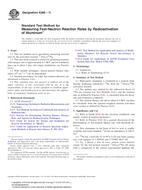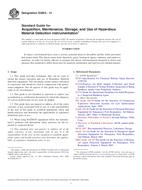Potřebujeme váš souhlas k využití jednotlivých dat, aby se vám mimo jiné mohly ukazovat informace týkající se vašich zájmů. Souhlas udělíte kliknutím na tlačítko „OK“.
ASTM E2304-03(2011)
Standard Practice for Use of a LiF Photo-Fluorescent Film Dosimetry System (Withdrawn 2020)
Automaticky přeložený název:
Standardní praxe pro použití jednoho LiF Foto-Fluorescent Film dozimetrie systému
NORMA vydána dne 1.11.2011
Informace o normě:
Označení normy: ASTM E2304-03(2011)
Poznámka: NEPLATNÁ
Datum vydání normy: 1.11.2011
Kód zboží: NS-44989
Počet stran: 8
Přibližná hmotnost: 24 g (0.05 liber)
Země: Americká technická norma
Kategorie: Technické normy ASTM
Kategorie - podobné normy:
Anotace textu normy ASTM E2304-03(2011) :
Keywords:
absorbed dose, calibration facility, dosimeter, dosimeter calibration, dosimetry system, electron beam, food irradiation, gamma ray, ionizing radiation, photo-fluorescent dosimeter, quality assurance, radiation processing, routine dosimeter, ICS Number Code 17.240 (Radiation measurements)
Doplňující informace
| Significance and Use | ||||||||||
|
A lithium fluoride (LiF)-based photo-fluorescent film dosimetry system provides a means of determining absorbed dose to materials by the photo-stimulated emission of wavelengths longer than that of the stimulation wavelength. The absorbed dose is obtained from the amount of the light emission. Imperfections within the ionic lattice of alkali-halide compounds such as LiF act as traps for electrons and electron holes (positively charged negative-ion vacancies). These imperfections are known as color centers because of the part they play in the compound's ability to absorb and then release energy in the form of visible-light photons. Like an atom, these color centers have discrete, allowed energy levels, and electrons can be removed from these sites when energy of the appropriate wavelength and intensity is transferred to the material. The resulting fluorescence spectra contain discrete peaks that can cover a range of wavelengths, depending upon the type of alkali-halide (8). An example of fluorescence spectra from a LiF-based dosimeter is provided in Fig. 1. A system of optical filters within a light-detecting instrument (that is, fluorimeter) can be used to block all but a narrow range of wavelengths that are desired for use. Theories on how color centers are formed, how luminescence mechanisms work, and their application in dosimetry are found in Refs (8-13). For characterization studies on specific photo-fluorescent dosimeters see Refs (1-7) and (14-19). In the application of a specific dosimetry system, absorbed dose is determined by use of an experimentally-derived calibration curve. The calibration curve for the photo-fluorescent dosimeter is the functional relationship between ΔEf and D, and is determined by measuring the net fluorescence of sets of dosimeters irradiated to known absorbed doses. These absorbed doses span the range of utilization of the system. Photo-fluorescent dosimetry systems require calibration traceable to national standards. See ISO/ASTM Guide . The absorbed dose is usually specified relative to water. Absorbed dose in other materials may be determined by applying the conversion factors discussed in ISO/ASTM Guide . During calibration and use, possible effects of influence quantities such as temperature, light exposure, post-irradiation stabilization of signal, and absorbed-dose rate need to be taken into account. Photo-fluorescent dosimeters are sensitive to light, especially during irradiation and post-irradiation stabilization (7). Some color centers are sensitive to the UV and blue regions of the spectrum, while other centers are only sensitive to the UV. Therefore, they need to be packaged in appropriate light-tight packaging shortly after manufacture, and during use they need to be packaged or the appropriate filters placed over room lighting. Filtering the light fixtures involved during irradiation may be required for irradiations using low-energy X-rays or electrons where unpackaged dosimeters are used. The signal from photo-fluorescent dosimeters either increases or decreases with time following irradiation, depending on the color center utilized (19). This stabilization process, which can last from hours to days depending on storage temperature (and dose for some color centers) can be accelerated and stabilized by heat treating the dosimeters after irradiation and before readout (see 9.2). Note—Also shown are transmission curves for green and red emission filters. FIG. 1 Excitation Spectrum and Resulting Fluorescence Spectrum from the Sunna LiF-based Film Dosimeter |
||||||||||
| 1. Scope | ||||||||||
|
1.1 This practice covers the handling, testing, and procedure for using a lithium fluoride (LiF)-based photo-fluorescent film dosimetry system to measure absorbed dose (relative to water) in materials irradiated by photons or electrons. Other alkali halides that may also exhibit photofluorescence (for example, NaCl, NaF, and KCl) are not covered in this practice. Although various alkali halides have been used for dosimetry for years utilizing thermoluminescence, the use of photoluminescence is relatively new. 1.2 This practice applies to photo-fluorescent film dosimeters (referred hereafter as photo-fluorescent dosimeters) that can be used within part or all of the following ranges: 1.2.1 Absorbed dose range of 5 × 10-2 to 3 × 102 kGy (1-3). 1.2.2 Absorbed dose rate range of 0.3 to 2 × 104 Gy/s (2-5)). 1.2.3 Radiation energy range for photons of 0.05 to 10 MeV (2). 1.2.4 Radiation energy range for electrons of 0.1 to 10 MeV (2). 1.2.5 Radiation temperature range of -20 to +60°C (6,7). 1.3 The values stated in SI units are to be regarded as standard. No other units of measurement are included in this standard. 1.4 This standard does not purport to address all of the safety concerns, if any, associated with its use. It is the responsibility of the user of this standard to establish appropriate safety and health practices and determine the applicability of regulatory limitations prior to use. |
||||||||||
| 2. Referenced Documents | ||||||||||
|
Podobné normy:
Historická
1.1.2013
Historická
1.6.2013
Historická
1.1.2013
Historická
1.1.2013
Historická
1.6.2011
Historická
15.1.2013
Odebírejte informace o nově vydaných normách ZDARMA:
Chcete pravidelně odebírat informace o nově vycházejících normách z celého světa a to zcela zdarma?
Přihlašte se k odběru. Vše je velice jednoduché a absolutně ZDARMA.
Na výběr máte vydavatele z celého světa.



 ASTM E262-13
ASTM E262-13 ASTM E263-13
ASTM E263-13 ASTM E264-08(2013)..
ASTM E264-08(2013).. ASTM E265-07(2013)..
ASTM E265-07(2013).. ASTM E266-11
ASTM E266-11 ASTM E2852-13
ASTM E2852-13
 Cookies
Cookies
